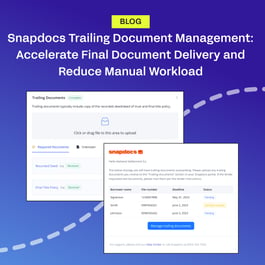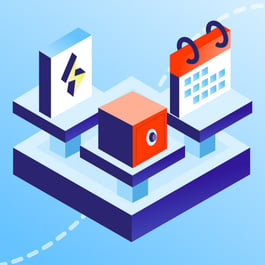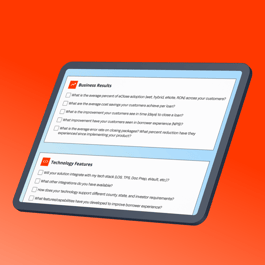A traditional mortgage closing includes a blizzard of printed paperwork and a sore signing hand at the final flourish. These traditional closings are symptomatic of the financial services industry being generally slow to respond when it comes to modernizing its practices. Because companies in every industry are compelled to adopt technology (particularly during the pandemic), consumers have come to expect a level of digitization within most facets of modern life. When it comes to purchasing a home, however, consumers have noticed the slow adoption of digital technology. Today, only about half of customers who recently refinanced or applied for a new mortgage said they were “very satisfied” with the transaction speed, yet 80% say they would be more likely to become a repeat customer if the speed of the transaction met their needs.
At a time when mortgage volumes may decline and put additional pressure on margins, lenders are more conscious of operational inefficiencies and organizational risks. Lenders also recognize that borrower experience is a top priority, especially as the market shifts from a refi-driven environment with a steady customer base to one where lenders are increasingly seeking new purchase borrowers.
In today’s competitive real estate environment, lenders are vying for new customers in a way that wasn’t as necessary during a refinance-driven market. Because of this market shift, a customer-centric focus is vital, and technology can be a key differentiator. In fact, a McKinsey study found that customers rated an “exceptional experience” nearly as important as interest rate when choosing a lender. Key factors defining this excellent service include reassurance, transparency, simplicity and speed.
That’s why lenders are recognizing the value of turning to digital mortgage closings – that is, one where loan documents, including the promissory note, may be signed and notarized in an electronic form – to offer a more streamlined customer journey and intuitive experience. The hallmarks of digital closings include simplicity, speed, and accuracy for borrowers, but the long-term benefits extend beyond customer satisfaction and can boost both productivity and satisfaction among lender staff.
A survey conducted by Snapdocs in partnership with National Mortgage News and Arizent Research identified key benefits of launching a digital closing process. Here are five top ways lenders are creating a healthier bottom line by implementing digital mortgage closing technology:
1. Improvement in error rate
Accuracy is crucial to achieving both a positive customer experience and employee satisfaction. No one benefits from wasted time, whether it’s redrawing docs on the closing team’s side, or having to return to the closing table due to missing signatures. Of the 100 lenders surveyed by Arizent Research, 67% of lenders report satisfaction with their error rates before adopting digital mortgage closings. After implementation of digital closings, this figure increases to 80%. The operational benefit is clear: Digital closings help lenders close accurately the first time.
2. Higher employee satisfaction
Nearly every industry is facing a talent deficit, and the mortgage field is no exception. National Mortgage News' 2022 prediction survey found that about half or more of respondents anticipate challenges recruiting back office personnel.
Digital mortgage closings offer a significant boost in staff morale – from 72% to 81% in the survey – which is crucial to any lender seeking to attract and retain talent. By turning to automation to handle rote tasks, workers are free to perform more strategic or customer-facing activities, which is beneficial both to them and to the organization as a whole.
One key factor must be that the technology is easy to adopt. Snapdocs, for example, integrates into existing loan origination systems, which makes it seamless for loan officers to execute the digital closing from their normal system of record.
Another key benefit of digital closings is the ability for staff to experience a single process for all closing types. Simplicity becomes even more important when staff feel beholden to multiple processes. In order to take advantage of the streamlined nature of digital mortgage closings, be sure to evaluate your tool’s ability to uniformly close all loan types, including wet, hybrid and full eClose.
3. Increase in NPS
Your net promoter score (NPS) is the most valuable metric your brand can command, as it gives you a simple way to benchmark customer sentiment in relation to competitors. The higher the score, the more likely your borrower will become an advocate and referral source, which is among the top ways to attract borrowers in a purchase-centric mortgage landscape.
The Arizent/National Mortgage News survey found that lenders reported significant increases in customer net promoter scores as a result of digital closing technologies.
4. Reduction in dwell time
Efficiency is the key to profit, and processing loans more swiftly means lenders can more quickly access capital to offer more loans. According to the Arizent/National Mortgage News survey, 83% of lenders who used digital mortgage closings saw their loan dwell time improve, up from 70%.
Digital technology can play a vital role in both increasing the top line and the bottom line. Not only does it help lenders originate more loans, but they are more profitable when they are easier to close and sell.
5. Reduced cost per loan
Combine this acceleration in efficiency with cost savings, and you’ve found the secret to success. Lenders enjoy a number of operational gains once they introduce digital closing technology. The Arizent/National Mortgage News survey reports positive performance related to overall operational efficiency with digital closings. In particular, respondents noted decreased loan production costs as a key benefit of digital closings solutions.
A frictionless experience drives success
Lenders are looking to technology to help improve efficiency, and are finding digital mortgage closings can amplify satisfaction from the back office to the borrower, while advancing the overall cadence of operations at all touchpoints.
Today, a digitally-enhanced mortgage closing experience offers a point of differentiation in the effort to woo customers – particularly when it comes to comparing the ease of a digital closing to the traditional, cumbersome systems of the past. But before long, user-friendly technologies will become table stakes for all transactions, and lenders who don’t adapt will be left behind.
Are you ready to reap the scalable benefits digital closings provide throughout the entire mortgage production lifecycle? Contact Snapdocs today to find out why 100% of its platform users are either “extremely” or “very” satisfied – and start experiencing the improvements for yourself.




















